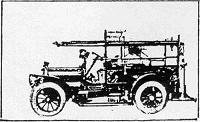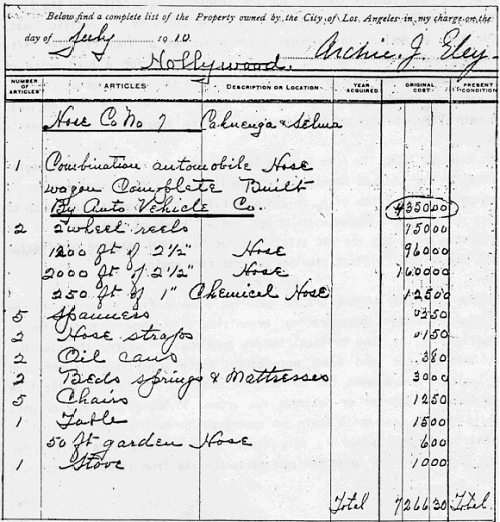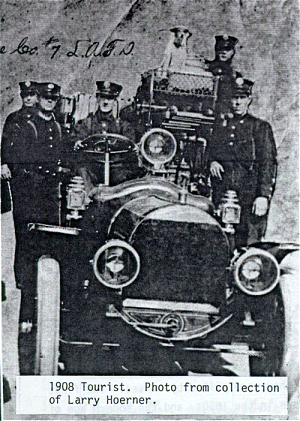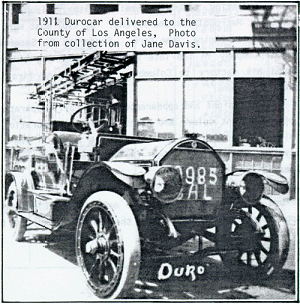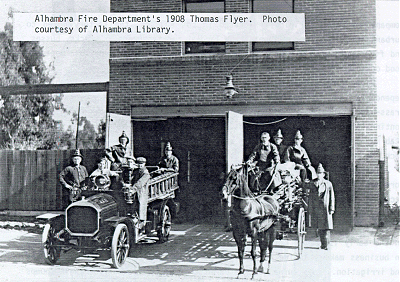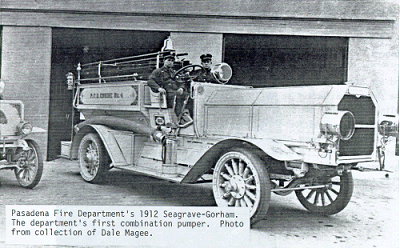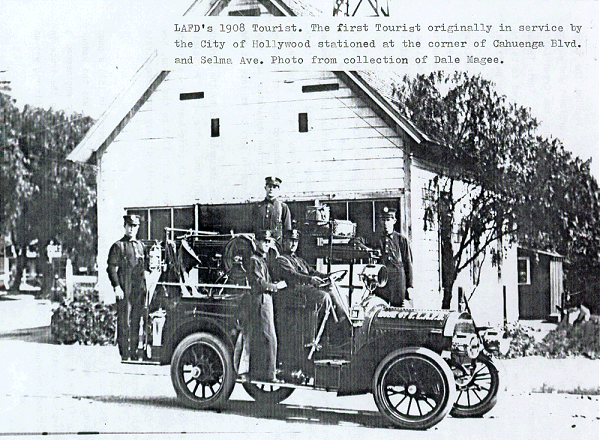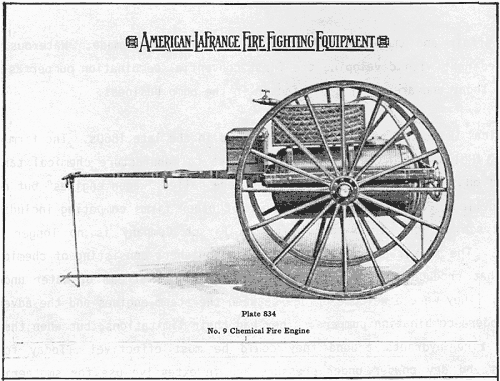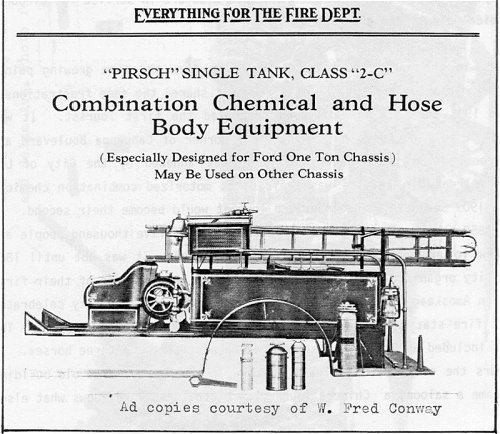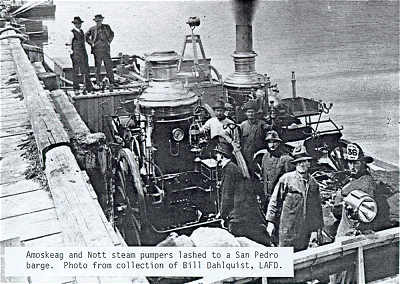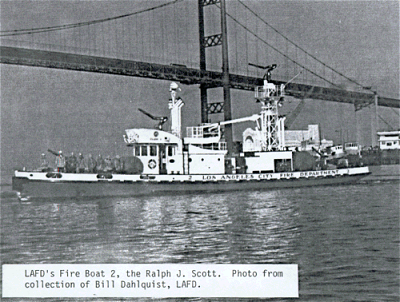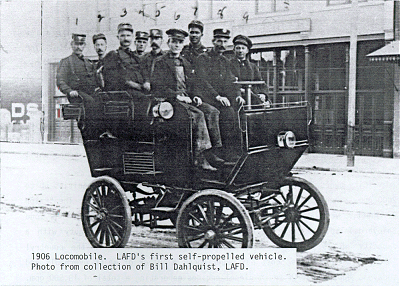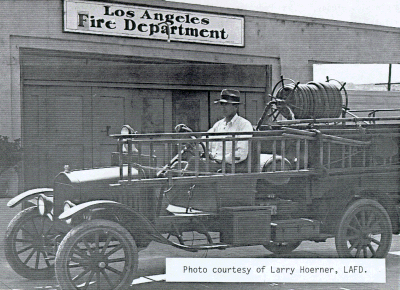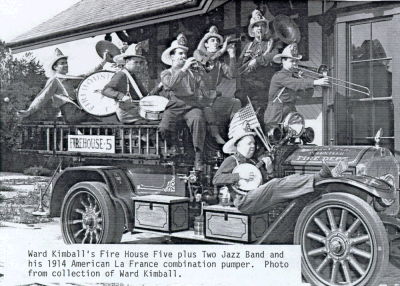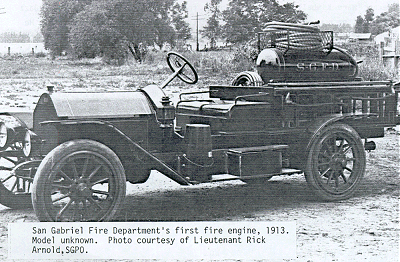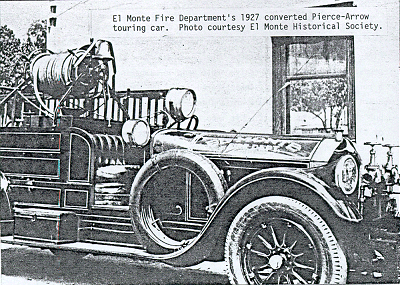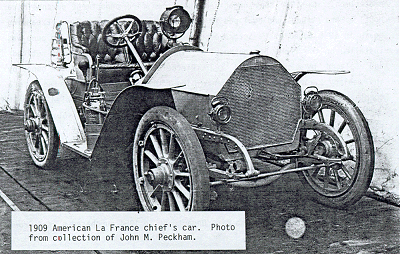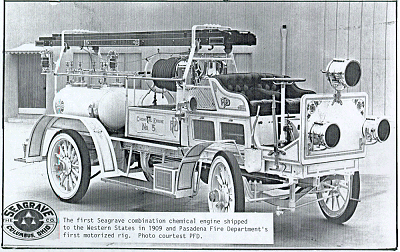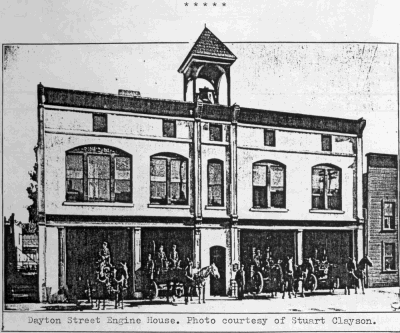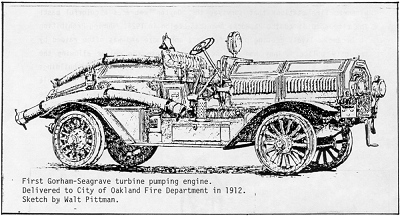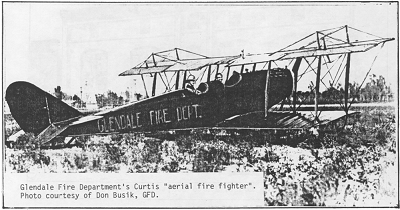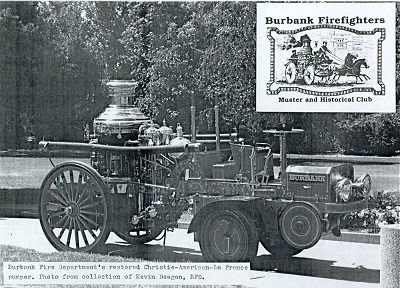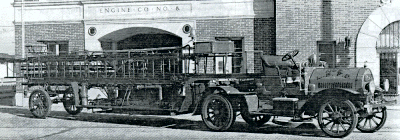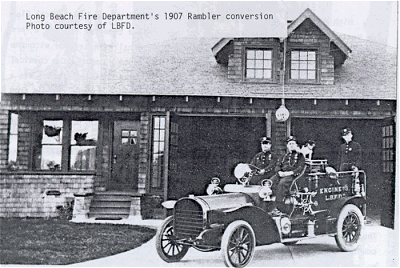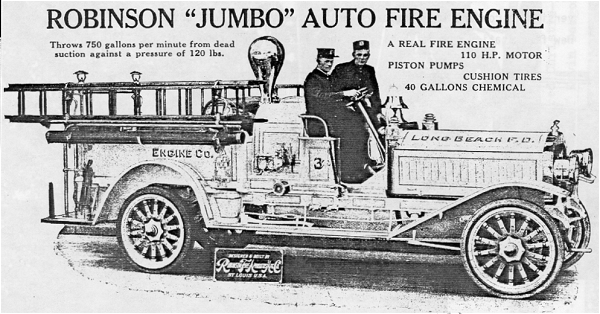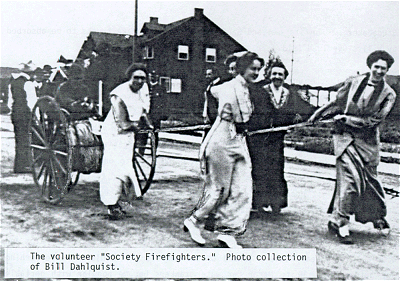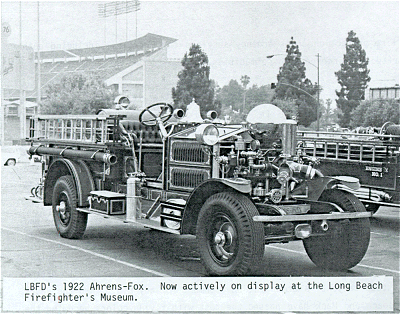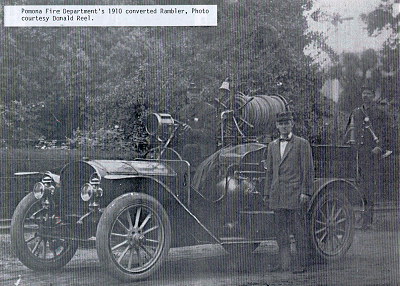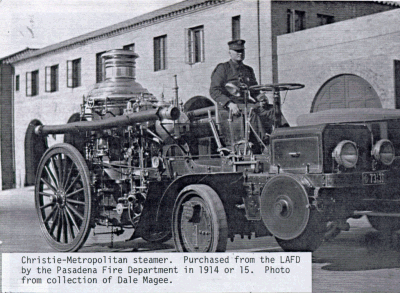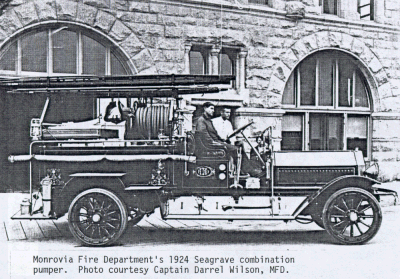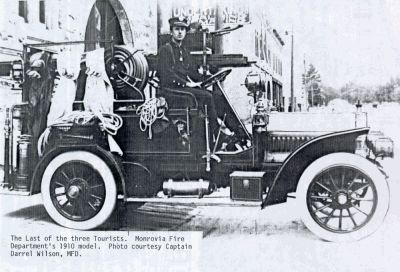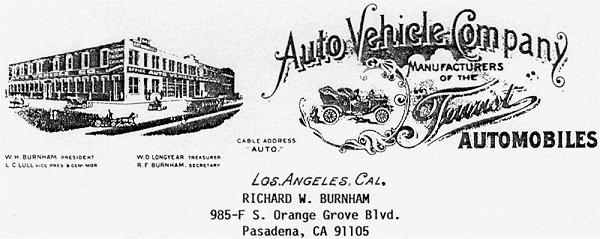| Note: |
This document
contains 21 pages of history, 30 photos, 3 historical add |
|
FIRE ENGINES AND MANY MORE * BY DICK BURNHAM The fire engine has always captured the fascination of young and old since the advent of the exciting horse drawn steam pumpers to the present day goliaths. The history of the fire engine is a long complex study. This will be a finite story mainly of Los Angeles County. The past hundred years there have been countless manufactures, big and small, producing fire apparatus-- and so it was with the Auto Vehicle Company and the Tourist. They delivered the first gasoline powered factory assembled engines to be built on the Pacific Coast. In 1907 they advertised in national trade magazines a "four cylinder fifty horsepower combination hose and chemical fire engine for a base price of $5,000." When the Auto Vehicle Company (AVC) closed their doors in 1910 they had manufactured over four thousand automobiles. However, only three of them were fire engines. And herein lies an interesting story about fire apparatus and this early period. On June 20, 1908, the Auto Vehicle Company arranged a Tourist fire engine demonstration for the Los Angeles City Council and fire department personnel. They whipped all over the city, up and down hills, thru tunnels, speeds up to 35 miles per hour and loaded with 12 men and all kinds of equipment! It was an impressive show, but the AVC still lost out to a 1909 Seagrave combination chemical engine--LAFD's first gasoline powered fire engine! * * * * * It was the beginning of the era of gasoline powered fire apparatus in the west. Townships were incorporating, organizing city owned fire departments and experiencing the same critical budget problems. However, the time had come to replace the hand drawn hose cars, horse drawn steam pumpers and ladder trucks. There were two choices: to contract for factory built fire engines like the Tourist or Seagrave for around $5,000. or buy new or used automobile chassis and build their own apparatus for half the price. Most of the conversions took place in city owned shops. There were mail order catalogs promoting fire apparatus and paraphernalia from ladders, hoses and chemical tanks to uniforms and fancy hats. American-La France and Pirsch & Sons advertised standard bodies that could be assembled on most automobile chassis complete with ladders and chemical tanks. Model T Ford were the most popular candidates. -1- |
|||||||
|
|
|||||||
|
The Los Angeles Times, on June 14, 1908, reported that the Los Angeles Gas and Electric Company had acquired a Rambler four cylinder touring car equipping it with fire fighting "paraphernalia". It was also stated that it was "the first of it's kind in America." It is interesting to note that the Los Angeles Times reported on December 11, 1907, that two Rambler chassis were being converted by the Long Beach Fire Department into fire engines. Rambler dealer W. K. Cowan was doing a brisk business also selling Ramblers to the cities of Pomona and San Diego. * * * * * In the beginning hose was made out of leather and rivets. When fire hose was fabricated out of woven materials, two-wheeled hose carts were in big demand. They were pushed or pulled by volunteer firemen. When the wagons became larger, loaded with ladders and tanks, they were pulled by horses. The first steam pumpers were introduced from Europe in the 1850's, and the modern age of the fire engine in America began. After the Civil War there were dozens of firms competing. Among them: Silsby, Clapp & Jones, Nott, Amoskeag, American, Metropolitan and Ahrens. By 1907 most were absorbed by American-La France from Elmira, New York. Frederick S. Seagrave founded the Seagrave Ladder Company in the late 1800s manufacturing ladders for general use. He moved his factory to Columbus, Ohio building first horse drawn ladder and chemical wagons. The designs and appearance of the early apparatus were most competitive. Lots of bright colors and plenty of ornate decoration. They were a beautiful thing to behold as is the modern fire engine. The uniform and helmets were stylish and even outlandish--the volunteers outdoing each other to show off in parades and social affairs. * * * * * Before the Tourist fire engine made its debut, the age of motorized fire apparatus was well underway in the east. In 1906 the Knox Automobile Company, in Springfield Massachusetts, delivered a "chemical fire car" built on one of their four cylinder air-cooled passenger car chassis. When the company folded in 1914 they had produced a wide range of passenger cars and fire apparatus. In 1907 the Seagrave Company in Columbus, Ohio demonstrated their first prototype combination chemical fire engine, and about the same time their distinguished competitor, American-La France, was doing the same thing. -2- |
|||||||
In Germany, in1888, Gottlieb Daimler is accredited with producing the first petrol pumper, but it was not self-propelled. Moses Merriweather, from England, beat Knox by two years and claimed to deliver the first self-propelled motorized fire engine in Europe. Although historians will argue the issue from here to eternity, it is not this writer's intention to swear on who built what first! * * * * * To follow the Auto Vehicle Companies in the fire engine business in Southern California was the Durocar Manufacturing Company, Moreland Truck Company and Crown Coach Company. In Northern California: Gorham Engineering and Fire Apparatus Company, Van Pelt Fire Equipment Company and Beck Fire Apparatus Company. Except for Beck they are all out of business. Durocar built only one fire engine--a combination chemical engine delivered to Los Angeles County in 1911. The first Tourist was delivered to the City of Hollywood; the second to the City of South Pasadena and the third to the City of Monrovia. * * * * * In the east were enduring names like Seagrave, American-La France, Ahrens-Fox, Pirsch, Webb, and many more. Detroit would soon be nibbling at the business and names would surface like Knox, Stutz, Locomobile, Pierce-Arrow, Reo, Studebaker and, of course, General Motors and Ford. The list is endless. The past hundred years to the present day it is estimated over a thousand manufacturers from the giants to the small body shops have built and are building all kinds of combinations of fire fighting apparatus. It has been suggested that entrepreneurs are attracted to the business because of the exciting memories of being a kid and watching and hearing the big red fire engines tear by! * * * * * Watt Moreland joined the AVC in 1902 and then to Durocar in 1908. His long time ambition to build trucks resulted in the founding of the Moreland Truck -3- |
|||||||
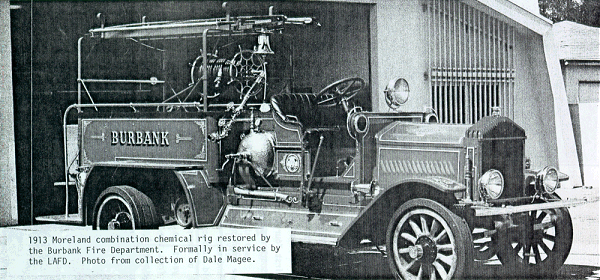 Company in 1911. Originally located in Los Angeles, the factory moved to Burbank in 1914 to become one of the largest manufacturers of trucks, busses, and fire engines in the west. The Los Angeles Fire Department soon became a good customer. Early Moreland fire rigs were no beauties, but they were durable and dependable and well known for their pumpers, foamite and water tankers and grass-wagon trucks for transporting fire fighters and equipment. Hercules and Continental engines were standards. In the twenties, Watt Moreland took a stab at designing passenger cars and airplanes. After a few prototypes of each, he concentrated only on trucks and fire apparatus. The depression years took their toll, and by the time of World War II the Moreland Truck Company was out of business, the factory buildings to be occupied by Lockheed Aircraft's Plant No. 2. There are a number of Moreland trucks, buses and fire engines in private collections and museums. * * * * * In the early 1900s the Gorham Engineering Company in Oakland, California was in business making a line of powerful pumps and engines for hydraulic mining and irrigation. They turned out to be ideal for adoption to fire engine pumps and were produced under the name of Gorham Fire Apparatus Company collaborating with Seagrave who, at first, shipped their bodies from Ohio to Oakland for pump and motor installation. Later the pumps were shipped to the Seagrave factory. They became classic powerful rigs known as Gorham-Seagrave and Seagrave-Gorham pumpers generating up to 1300 gpm--the first centrifugal pumpers built for fire-service in the nation. The first combinations were delivered to the cities of Oakland, Pasadena and San Diego. With the long extended hoods the body styles were startling! The pumps were located to the rear of the driver's seat driven by four or six cylinder engines. Most all pumps today are located in the center of a rig. There was one exception: Ahrens-Fox from Cincinnati, Ohio who mounted their pumps exposed in front of the radiator---a bizarre looking affair that became their trade mark. Two Ahrens-Fox rigs in perfect condition are on display at the Long Beach Firefighter's Museum and a Gorham-Seagrave is gathering dust in a Los Angeles County Museum of Natural History warehouse.
|
|||||||
|
|
|||||||
|
Another Los Angeles entrepreneur, Donald M. Brockway, founded the Crown Carriage Company in 1904 manufacturing a line of quality carriages and wagons and perhaps a few hose carts to become in a few years the Crown Coach Corporation building motor coaches, busses and two airplanes. Their famous line of Firecoach apparatus was introduced in 1951 and considered to be the "Cadillac" of the industry. More expensive than most of their competition, they were in demand for their engineering excellence. The Brockway family sold the Company in 1980 when it became the Crown Coach International moving to Chino, California. The last Firecoach rig was delivered to the Santa Monica Fire Department in 1985, the factory closing in 1991. There are still many Firecoaches in service and will be for some time. If collectors are interested, they may contact the Crown Firecoach Club in Capistrano, California. * * * * * In 1912 a race car driver by the name of John W. Christie designed a two-wheeled, two cylinder, 40 horsepowered tractor manufactured by the Front Drive Motor Company from Hoboken, New Jersey. These unique units assembled permanently to the front end of a steam pumper or aerial ladder truck replacing the horses and extending their service by many years. Seagrave and American-La France were soon building two and four-wheeled tractors attached to steamer, ladder and chemical wagons. Horse drawn apparatus was soon doomed. However, a few horse drawn steamers were in service as late as the early twenties. Christie restorations today are few. The steamer owned by the Burbank Fire Department is one of the best known--the only one in the west. Horseless Carriage Club member, Lindley Bothwell, owned a Christie-American-La France that was an alumnus of the LAFD. He sold it in 1963 to the Wayne, New Jersey Fire Department for $4,000 who now proudly display and demonstrate another restored jewel. * * * * * The Waterous Engine Works from St. Paul, Minnesota pioneered in 1898 a pump engine that was assembled on small wagons and carts. Next, was the Radnor Fire Engine Company in Fort Wayne, Indiana. In 1907 they engineered a duel-pumper featuring two Waterous engines--one for propelling the truck in front and the other located in the rear driving the pump. This rig was an awkward affair and there is no record on how many were made. Waterous is accredited next with developing the first conventional combination pumper as it is known today and are still a big factor in the pump business. -5- |
|||||||
|
The chemical method of fighting fires surfaced in the late 1860s. The firm of Babcock & Holloway, in Chicago, was the first to manufacture chemical tanks assembled on hose carts and wagons. They were called "wagon engines" but not self-propelled. There were soon a number of other firms competing including Peter Pirsch & Sons in Wisconsin. The Pirsch Company is no longer in business. The tanks were like huge fire extinguishers consisting of chemical agents that produced carbon dioxide gas propelling a stream of water under pressure. They were a welcome bridge between the steam engines and the advent of the modern combination pumpers. They had their limitations, but when there were no fire hydrants around they could be most effective! Today foam chemicals and dry powder under pressure are in extensive use for smothering fires. Specially designed chemical tank apparatus are in service for airport, petrochemical plants and oil fields. * * * * * All cities in the early 1900s
were struggling thru the same growing pains. The following stories
are typical of a few that shared the same frustrations: In 1850 the population of Los Angeles was about five thousand people and only a few volunteer firemen were scurrying around. It was not until 1869 that the city organized a volunteer department and the purchase of their first steamer, an Amoskeag from New Hampshire. In February 1886 the City celebrated its first fire station, Engine House 1, at the sight of the Old Plaza. The apparatus included an Amoskeag steam pumper, a hose cart and three horses. In a few years the city lost its lease on the Plaza property. The old building soon became a saloon, a Chinese laundry, a brothel and lord knows what else. -6- |
|||||||
|
In a shambles for many, many years it was finally restored and dedicated as a California Historical Landmark on October 1960 and is now a fascinating museum. In 1907 the fire commission approved the purchase of a "self-propelled" Locomobile nine passenger vehicle for official use. Pictures of the strange looking automobile indicates it was a custom body. In 1908 a Haynes three seated sporty runabout from Koko, Indiana was assigned to the chief. Why wasn't this a sporty Tourist runabout? The next year their first Seagrave chemical engine was delivered. By 1908 the LAFD had grown to twenty-four stations fully equipped with a roster of Nott, Amoskeag, Ahrens, Metropolitan and American La-France steam pumpers. Also Babcock, Seagrave and Anderson hose and ladder wagons and over ninety horses. The area of San Pedro was annexed in 1909 and, along with Hollywood, Chief Archibald Eley had two new areas demanding better fire protection. The Chief was determined to expand and motorize his department, but was confronted with a City Council that was sorely strapped for money. However, there were way to skin the cat! Many of the horse drawn steam pumpers and ladder wagons still had many miles left. To modernize existing apparatus, Christie two-wheeled tractor and American La-France and Seagrave four-wheeled tractors were attached to a number of rigs, thus replacing the horses. All of the Christies and horse drawn steamers were retired by 1923 and a splendid era in the history of fire fighting gradually faded away. The departments first gasoline powered combination pumper was a 1911 Jumbo Robinson from the Robinson Apparatus Company, St. Louis. The 750 gpm rig cost $8,650. They next contracted for a hefty 1913, 1,000 gpm Gorham-Seagrave. By 1915 the LAFD became one of Moreland Truck Company's best customers purchasing, at first, chassis only for combination conversions in the L.A. city shops. * * * * * By the time the area of San Pedro and all its tidelands was annexed by the City of Los Angeles, it had become a vital point of entry for wooden hulled ships unloading vast cargos of lumber and other combustibles on wooden docks. -7- |
|||||||
|
When a fire started, which it often did, there were only a few volunteers with nothing much more than buckets and carts to fight with. The harbor was growing by leaps and bounds and fire chief Archibald Eley had his work cut out for him. The L.A. Fire Department's first combination chemical and hose engine, the 1909 Seagrave, was assigned to San Pedro. Two tug boats were leased and equipped with pumping apparatus and land fire stations were built, but more harbor boats were sorely needed. In desperation, Chief Eley ordered two steam pumpers lashed to a barge to be pushed and pulled by harbor tug boats! During this time the fire fighters were living in tents until proper housing was built. City owned fire boats were soon in service with pumping capacities up to 2000 gpm. Then came the big break in 1925; the famous Fireboat 2. The "Ralph J. Scott," was launched by the Los Angeles Ship Building Company (later known as Todd Shipyards) at a cost of $214,000--a 100 foot steel-hulled beauty with a capacity of 15,500 gpm. She was considered the finest in the country! Through the years the Scott has experienced a number of major overhauls and today is equipped with seven diesel engines generating a total of 18,500 gpm. a classic. Today, in San Pedro and Wilmington, there are four boat docks and a total of five fire boats. The Ralph J. Scott is docked at Station 112 next to the Marine Museum in San Pedro. Pilot Wm. E. Dahlquist has written a number of interesting stories about this historic era. * * * * * On December 24, 1908, the South Pasadena Daily News announced the delivery of the city's first fire engine, a Tourist, manufactured by the Auto Vehicle Company at a cost of $4,750. It was a time for celebration. The paper featured a picture on the front page listing all the numerous accessories. It also mentioned that to start the engine quickly the truck has to be coasted down an inclined skid-way inside the station. Their second rig was a 1914 Gorham-Seagrave combination. The citizens of South Pasadena and the valley had good reason to celebrate. The day of the horse carts and volunteer firefighters were soon over. Many would remember well the spectacular Raymond Hotel fire on Easter Day 1899. -8- |
|||||||
|
* * * * * The city of San Gabriel incorporated in 1913 and purchased a used touring car (model unknown) to be converted into their first fire engine. Captain Lynn Youngs of the San Gabriel fire Department tells the story of his grandfather, Arthur Roe, who was the first Fire Chief, assembling the body and equipment in his garage. The department's second rig was a used 1917 American La-France combination pumper. The present chief, Gene Murray, (formerly Chief of the South Pasadena Fire Department) has written an interesting history about both cities. A long time City of San Gabriel resident is Horseless Carriage Club member Ward Kimball who is well known for his Firehouse Five Plus Two Jazz Band and narrow gauge railroad. He, of course, collects fire engines. He owns a 1915 American La-France pumper that was originally in service by the City of Venice and later owned by the Wilshire Oil Company as a stand-by truck. Kimball has put it to dramatic use as a prop for his band in parades, movies and TV. He has restored a 1911 two seater two cylinder Maxwell chief's car. Also, sitting in his barn is a rare 1888 Silsby steam pumper form Seneca, New York and served as the only fire apparatus in the small town of Cederville, Ohio. An interesting addition to his collection was the LAFD's 1910 Anderson ladder truck attached to a 1913 Seagrave four wheeled tractor. Kimball bought it from wild animal trainer Louie Gobels of Thousand Oaks in 1950 and in a few years generously gave it to Travel Town in Griffith Park to join the display of other interesting LAFD fire apparatus. -9- |
|||||||
|
* * * * * The Alhambra City Board of Trustees in 1906 created a special Committee on Fire Protection to recommend the purchase of fighting equipment and procedures. They had aggressive and expensive plans including a fire station, a horse ladder wagon and sophisticated alarm and water systems. In 1908 the Board approved the purchase of a Thomas-Flyer gasoline powered chassis from Buffalo, New York, converting it into a chemical fire engine at at total cost of $3,850--way over budget! Called "Old Betsy" it was stationed next to the ladder wagon across the street from the stable. The second rig was a 1913 Webb pumper from St. Louis. Soon all the volunteers were replaced by a salaried full-time force, but the department was still well over budget. Chief Jasper Pugsley suggested the city knockoff answering alarms outside the city limits--not a popular happening for communities like Arcadia, San Marino and Rosemead who were dependent on the L.A. County for fire protection. * * * * * The City of El Monte is situated over a large subterranean body of water. The early volunteers were called the "Bucket Brigade" and not too well organized even though well supplied with water and buckets! By 1913 the city depended on the San Dimas District of the L.A. County Forest Service for fire protection. By 1920 they organized their own fire department purchasing a Model T Ford truck and equipped it with all the usual apparatus. Expanding again in 1926 added was a Seagrave pumper, and a separate 350 gallon pump was installed on the front of the Model T. In 1932 the Ford Model T was retired and replaced by a choice used 1927 Pierce-Arrow touring car, once owned by the wealthy Keck family in Pasadena. The Pierce-Arrow was converted into a combination fire truck with the pump from the old Model T assembled in front of the radiator! In 1940 El Monte passed a bond issue for salaried fire fighters, a new fire station and later a new Mack "Bulldog" combination pumper. * * * * * The City of Pomona Fire Department was formally organized in 1883 by dues-paying citizens volunteers. For the years to follow an annual Fireman's Ball was held to raise money for expanding the desperate need for fire fighting apparatus. Their first motorized rig was a 1910 Rambler conversion. The near by City of West Covina Fire Department in 1954 purchased a used Crown Firecoach combination pumper that was the first fire engine Crown built in 1951 and was used as their demonstrator. Today the rig is owned by retired Firefighter Chris Arnold and his father Larry Arnold. -10- |
|||||||
|
* * * * * In 1909 the City of Pasadena contracted for a Tourist fire engine. The AVC was unable to meet the contract requirements and the order was cancelled. A 1909 Seagrave combination chemical engine was ordered in its place and promptly shipped from Columbus. The first motorized rig Seagrave delivered to the Western States powered by a six cylinder air-cooled engine. It was described as an elegant four-wheeled chemical giant to become the famous No. 5 and in later years beautifully restored by fire fighters young and old appearing many times in the Tournament of Roses Parade. In 1887 Pasadena's first volunteer fire department was organized and construction on the historic Dayton Street Station was started. The first apparatus consisted of a Nott steam pumper, a hose wagon, a hook and ladder wagon and six horses. The first fire chief, A. S. Turbett, was paid a salary of $25 a month and a firemen's salary was $10. One of the qualifications for the job was to be able to play a band instrument, and the City Council soon posted a notice that gambling and drinking inside the station was prohibited! The PFD was and still is the largest department in San Gabriel Valley boasting the only steam pumpers. To follow Seagrave No. 5 were two more similar hose and chemical rigs and a used Christie-Metropolitan steam pumper from the LAFD. In 1912 the city purchased their first motorized pumper, a Gorham-Seagrave. A Seagrave aerial ladder truck was added to the roster in 1914 and was not retired until 1936. By 1918 all of the horse drawn apparatus were retired. It was common to overhaul the old Seagraves and replace the 6cylinder air cooled engines with water cooled Pierce-Arrows. During critical economic periods, such as recessions and war-time conditions, city owned and local shops everywhere are burdened with the job of extending the service of their apparatus. The Dayton Street station and livery barn have been restored by the present owner Stuart Clayson where he now has his offices. As with all historic fire stations that survive, the "Dayton" -11- |
|||||||
|
embraces a colorful past! The city sold it to the Pasadena American Legion in 1924. During Prohibition it became a lively meeting place for jazz and booze and was often raided by the city police. They had an escape hatch into the cellar allowing the brethren to elude the raids. In later years the station and other buildings in the block were purchased by Al Preble who operated a successful vegetable and florist business. Around the corner from Dayton street is now located the new Pasadena Fire Station 31 where the trusty old Seagrave No. 5 is on permanent display. * * * * *
-12- |
|||||||
|
The City of Glendale approved a bond issue in 1907 to support their first fire protection program which included a fire station, two fire hydrants and a few fire extinguishers. The hose-ladder truck, horse and harness cost $429.25. The stable was located inside the jail, and the City Marshall became the first fire chief. An organized volunteer fire company was in force until 1922. The first few years the department experienced little action until a disastrous fire destroyed most of a downtown city block. The Board of Trustees approved the purchase of a 1913 Knox chemical fire engine from Springfield, Massachusetts. In 1914 the city bought their second Knox for $6,250. In 1922, A. H. Lankford became the first paid fire chief at a salary of $110 a month. Chief Lankford and one of his firemen bought a used war surplus Curtis bi-plane and painted it bright red with "Glendale Fire Department" boldly printed on the fuselage. Known as an "aerial fire truck" it was stationed at the Grand Central Airport in Glendale effectively spotting firs and fighting them whenever landings were possible. The GFD Muster Club is active doing a fine job of restoring old apparatus. A retired 1924 Seagrave pumper was sold to the City of Fawnskin, Big Bear Lake. After changing ownership many times the Club bought it back and restored it to its original design. In process of restoration is a 1924 American La-France combination pumper bought from John Wayne's estate. The original 1913 Knox is now owned by Horseless Carriage Club member Alvin Frankel of Los Angeles and is a restoration potential. Needless to say, the Glendale Muster Club members are eyeing it with considerable envy! * * * * * The City of Burbank incorporated in 1911. It would take five years before they organized a modern fire department. In the meantime, volunteers were fighting fires with the usual hose carts and hitching a ladder wagon to an automobile. The first fire engine was a 1916 Seagrave pumper stationed in the new city hall which included an apartment for the Fire Chief, Homer Davis, and his wife. He was also the city janitor, and Mrs. Davis manned the switch board! Although the Moreland Truck Company was only a few blocks away building damned fine fire engines, the city's second, in 1924, was another Seagrave! however a Moreland would soon follow. -13- |
|||||||
|
High marks are due the Burbank Firefighter's Muster and Historical Club for restoration excellence of a 1913 Racine-Moreland chemical rig and a rare Christie-American-La France steam pumper both originally in service with the LAFD. The original Moreland chassis was converted into a combination chemical rig including the assembly of a Racine hose-body. The Christie tractor was a 1914 model attached to a 1908 American-La France steamer. After retired from service, both rigs ended up at the Warner Brothers Studios for movie props and in time were badly neglected. Warners finally gave them to the Burbank Firefighter's Muster and Historical Club. The Moreland is on display at the Gordon Howard Museum in Burbank, and the Christie is an elegant thing to behold on display at Fire Station No. 21. Both are featured often on parades and special events. They can barrel down the boulevard at an easy 40 mph! * * * * * The City of Long Beach had one of the most innovated fire departments in the county budgeting in 1906 for a fully staffed fire department and the apparatus to go with it. Included were a Metropolitan steam pumper, a hose and ladder truck and a stable of horses. The city moved aggressively into the age of motorization buying two new Rambler automobile chassis in 1907. After conversion to combination chemical rigs they were ready for service in 1908. Two new fire stations were built looking like neighborhood cottages. They had two bays and two apartments each where the fire fighters and their families lived in considerable comfort! A Seagrave four-wheeled tractor soon replaced the ladder wagon horses. By 1912 they boasted a hefty Robinson Pumper from St. Louis and a six cylinder Mitchell chief's car from Racine, Wisconsin. To follow was a big ugly Gorham 1000 GPM pumper and an Oldsmobile custom-bodied chemical car. By then the steam pumpers and horses were retired except for one horse to pull a wagon for servicing fire plugs.
-14- |
|||||||
|
The disastrous earthquake, March 10, 1933, left Long Beach devastated. Four fire stations were destroyed. There were few fires, but it would take months before fire protective operations were back to normal. Retired apparatus as old as the 1906 ladder truck were put into service and surrounding cities offered unlimited help, including the Sierra Madre volunteers. Located in old fire Station 10 is the Long Beach Firefighters Museum. Under the direction of retired engineer Herbert Bramley, firefighters active and re-tired are busy restoring all sorts of apparatus. By all means pay it a visit!! * * * * * The City of Santa Monica purchased a 1912 Garford truck chassis from Elyria, Ohio converting it into the usual chemical rig using parts from old horse drawn apparatus. Although Santa Monica does not have a harbor like Long Beach and San Pedro, its big attraction was the Ocean Park Pier and its extensive frontage of buildings--all a tinder-box of wood. The harbor cities had the advantage of fireboats. Santa Monica had only land stations. In September of 1912 was the big one. A fire broke out on the Ocean Park Pier and quickly spread destroying all the frontage buildings and burning out of control east into the city areas. Calls went out for help and Chief Archibald Eley responded sending three of his newest pumpers. The fire prompted the city to purchase another Garford in 1913 and their first Seagrave pumper in 1915. The Santa Monica Garford Trucks bring to mind an interesting story: The Garford Company (1903-1913) originally built components and chassis for the automobile industry. One of their early customers were wagon makers by the name of Studebaker Brothers from South Bend, Indiana who dabbled in automobiles. A few cars were built known as Garford-Studebaker. By 1907 Studebaker was on its own and Garford continued to make trucks to be absorbed by Willys-Overland 1913. -15- |
|||||||
|
The story of the unincorporated areas of Los Angeles County and fire protection is complex. At the turn of the century there were over 4,000 square miles of mountains, valleys, foothills, desert, coast and urban lands--most of which had no fire protection whatsoever. In spite of the State Board of Forestry and other agencies, there was no central organization to coordinate the purchase of adequate fire apparatus or the men to operate them. Forest fires would simply burn themselves out and buildings burn to the ground! By 1900 it became good business for the private sector to support the county volunteers. They organized the Forestry Land and Water Society of Southern California to help finance needed equipment. At first, hose carts and chemical wagons. Later, cars and trucks converted to fire apparatus and specially designed trailers loaded to the gunnels that could be hauled behind any automobile. White Motor Car water tankers became popular with portable pumps installed on top of the tanks. The Durocar was believed to be the county's first motorized fire engine. During the 1920s the Army Air Corp. patrolled forestry areas of the western states under the command of Major "Hap" Arnold, flying World War I surplus De Haviland DII-4s based at March Air Base, Riverside, California. Well into the 1900s many cities throughout the county were incorporating and organizing their own fire departments taking the "heat" off the county. At long last, to emerge from the Los Angeles County Forestry Department was the Los Angeles County Fire Department. By 1924 there were over 26 Fire Protection Districts (fire stations) that were to be staffed with salaried fire fighters and become the third largest department on the West Coast. Divided up among the districts were a conglomerate assortment of fire fighting apparatus from hose carts to modern day pumpers. Included were old timers like Reo, Stutz, Kissel, Dodge, Pierce-Arrow, Moreland, White, Ford, Lincoln and Cadillac. Except for new rigs like Seagrave and American-La France, most of the other apparatus were body conversions. Today (1992) the County Department provides fire protection and emergency services to 48 cities, including both unincorporated and incorporated communities. -16- |
|||||||
|
* * * * * The City of Sierra Madre boasts the only all-volunteer fire department in San Gabriel Valley and a fine one it is. In the early 1900s a handful of men calling themselves the "Fireman's Club" depended on antiquated fire equipment until 1921 when an organized fire department was unified by a growing community. Their first engine, by conscriptions, was a used American-La France combination named "Old Snort." Their second, a used V-8 Pierce-Arrow limousine that the boys converted into a ladder and hose rig. There are thirty volunteers from all walks of life experiencing a rigorous training and making many sacrifices--truly dedicated men and women. The present chief (1992), Edward D. Tracy, is an administrator at Paramount Studios in Los Angeles. Sierra Madre is nestled below the San Gabriel Mountains and laced with narrow roads and steep canyons--a demanding environment for any rig. Thru the years Crown Firecoach and Mack have passed the test with flying colors becoming the department's most popular rigs. * * * * * The story of the firefighter dates back to early history. In early Roman days there were slaves and volunteers until the year of the great fire in 6 AD resulting in the Emperor Augustus ordering the formation of the Corps of Vigilis--paid fire fighters that shared the same status as the Roman Legions. They became a formidable fighting corp. that lasted for four hundred years. Egyptian history records as early as 200 BC sophisticated methods of fighting fires using pumping devices. Ben Franklin was accredited with founding the Union Fire Company--the first organized fire fighting volunteers in America. They had little to fight with mainly buckets and hand pumps that barely squirted a stream and only then if there was a body of water near the fire to draw from. Throughout history a volunteer has been a long suffering dedicated soul. Sadly, many times they had to stand by and helplessly watch buildings burn to the ground. They could be well-trained, organized, and disciplined or just the opposite! Nevertheless, through the ages, high accolade is due them. Many cities and urban areas are still dependent on the volunteer supported either by city government or self-supporting. They are most common in the eastern states. -17- |
|||||||
|
Yes, there were women volunteers. In 1912, Chief Archibald Eley of the LAFD made the bold move encouraging women to fight fires in their own neighborhoods as a protective gap until the regular fire fighters appeared on the scene. They were well trained and equipped with two-wheeled hose carts. Often called "Social Firefighters" they apparently did a commendable job. There is a wonderful photograph showing five ladies dressed to the hilt in the latest styles pulling a hose cart down the middle of a street. * * * * * The horse deserves special accolade. They were well trained, dedicated, respected, and became an intimate member of the fire-house family. The best horses, Morgans and Percherons, were bred in the south. After they arrived at their destination they went through a post graduate course to become familiar with the new environment. It was suggested they knew the ins-and-outs of getting around the city better than the driver! There is a wonderful photograph of two steam pumpers pulled by three horses each galloping down the boulevard, smoke bellowing out of the stacks, obviously racing to see who can get to the fire first. What a thrill it would have been to have ridden on one of them. What a thrill it would have been just to have watched one! There is a legendary story of a milkman who bought a retired LAFD horse in 1920 to pull his delivery wagon. Whenever there was a fire alarm nearby, the milkman's horse would tear down the street in pursuit of the fire with milk cans and bottles flying in air! True or not this was not an uncommon happening. In 1938 the last of the LAFD horses "Old Blackie" quietly passed away in a San Fernando Valley nursing home. * * * * * Little known is America-La France's brief entry into designing and building passenger cars. At the time they were aggressively promoting their fire apparatus business the company spent large amounts of money and time, from 1901 to 1910, engineering a first class four cylinder passenger car. They built prototypes and actually delivered a few smartly styled model's featuring both La France and American-La France names. Records and details are obscure and how many cars were made is not known. Figgie International, the parent company of American-La France, own a restored 1910 4 cylinder 75 horsepower race car. It is believed that most of the early models were owned by company officials. Fire chief's cars were also produced. -18- |
|||||||
|
* * * * * A few Horseless Carriage Club members are collectors. Alfred Frankel of Los Angeles is restoring the City of Glendale's first chemical engine, a 1913 Knox. Also, from Los Angeles, Donald Reel has stashed away a 1908 Rambler in bits and pieces that was a chassis conversion and the City of Pomona's first motorized apparatus. Roger May, from Mesa, Arizona, owns a prize 1911 American-La France chemical rig that was the first A-L delivered to the west coast and originally owned by the City of Grants Pass, Oregon. It shows up often at HCC tours. Boyd Goddard, from rancho Santa Fe, California is restoring a 1914 American-La France from Worcester, Massachusetts that he and his wife picked up in 1989. Also, a 1915 American-La France originally owned by the Los Gatos, California Fire Department. * * * * * The modern day combination pumpers are a fire station's main-stay as was the Tourist chemical combination in its time. Today's rig cost over $225,000, features a V-6, 240 horsepowered diesel engine--usually a Cummins, Detroit or International and a Waterous 1500 gpm pump and equipped with ladders, hose and tanks. They have a wheel base of 166 inches, weigh about 35,000 pounds and are often in service for as long as thirty years, enduring a few overhauls. There is no such thing as a production fire engine. Almost no two rigs are alike. Each city contracts for their own specifications depending on the environment and needs. When a new rig is delivered she is anticipated like a new born child--a member of the family and firefighters are dedicated to her care for life! Today when a new rig is ordered from the east, she is often driven from the factory to the west coast. A job that is assigned to three or four fire fighters--an experience they never forget. Imagine wheeling a 100 foot Seagrave tiller ladder truck all the way form Clintonville, Wisconsin. Or, how about fifty years ago wrangling west via Route 66 on high crown roads? However, fifty years ago all apparatus was shipped by rail. -19- |
|||||||
|
Old fire engines never die nor do they easily fade away. When a rig is retired they are often kept in reserve and, if necessary, overhauled extending their service for many years. There is a market for them in smaller communities and especially in Mexico where sooner or later they end up for spare parts and only then "fade away." Firefighters always speak fondly of the departed and try to keep in touch with their friends wherever they may be. They belong to their "Muster Clubs" and take great pride in perpetuating the restoration of the antiques and classics and are always grateful for financial help! Among the museums scattered throughout California featuring fire apparatus are: Travel Town in Griffith Park, Los Angeles County Fire Museum, the Long Beach Firefighters Museum and San Diego's Pioneer Hook and Ladder Association. One of the finest in America is the Hall of Flame in Phoenix, Arizona. * * * * * The City of Monrovia was delivered the third and last Tourist in May 1910 and at the same time relieved to be rid of the volunteers who were considered to be no less than a social club. One time early in the year there was an alarm and the boys responded pulling their hose carts, but forgot to bring the hydrant wrench. Of course, the house burned to the ground. The irate citizens finally convinced the City Board that the time had come to budget for a full-time department. However, they could not afford a fire engine. A wealthy Monrovian, L. B. Vollmer, came to the rescue and purchased the Tourist from the California Automobile Company (who absorbed the AVC in 1910) and leased it back to the city for fifty dollars a month! In a few months Monrovia proudly owned their first engine. It was the Tourist that was ordered by the City of Pasadena. The second was a 1917 Seagrave pumper and the third a 1924 American-La France. Only then was the Tourist retired--the longest stint of all three. It was believed that Chief George King drove the old rig home and stored it in his garage. A happening that was soon lost to history as have the others. The South Pasadena Tourist was retired in 1914. The last reference to the Hollywood/Los Angeles rig was noted on the LAFD's annual report listing it as had been given "a general overhaul" in 1913. R. Dale Magee, in late 1992, reported a reliable source rumored that the Monrovia-Tourist still exists and had been seen somewhere in the San Gabriel Valley. Needless to say an extensive search is underway. Is it possible that Number 3 will some day soon surface in someone's garage or barn covered with dust and old newspapers? On this exciting prospect this story ends! FINIS -20- |
|||||||
|
I am indeed grateful to
historians R. Dale Magee, Walter Pittman and James L.
Valentine. Without their patience and help this story would have
been impossible. Also, I have unbounded gratitude to many, many
fire fighters, young and old, throughout Los Angeles County who have
become good friends. What a fine dedicated lot they are.
Among them: Captain Scott McClure and Scott Dandridge (PFD).
Captain Darrel Wilson (MFD). Pilot Bill Dahlquist and Larry
Hoerner (LAFD). Captain Corey Creasey and Don Busik (GFD).
Battalion Chief Jack Nare, retired and Kevin Deagon (BFD).
Engineer Herb Bramley, retired (LBFD). Roni Roseburg (SMFD).
Chris Arnold retired (AFD). Chief Gene Murry (SGFD). Captain
David Boucher (LACO). Battalion Chief James A. Schieldge, (WCFD).
Retired Chief Charles Brown, (SMFD). Also, historians Steve Baker,
Larry Arnold and Fred Love. And, last but not least, Stu Clayson
and Ward Kimball. I have referred to the books "Ride the
Devil Wind" by Capt. David Boucher, "A Century of
Service" by Paul Ditzel and "Fire" by Simon Goodeman.
Also, a soon to be published book "Chariots for Fires" by
Magee and Pittman. My files are now full of fascinating
material--much more than is written about in this story! DICK BURNHAM
-21- |
|||||||
LAFIRE.COM
Copyright 1999 All Rights Reserved.
